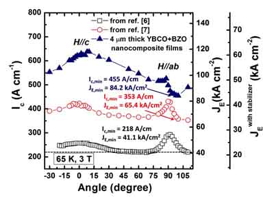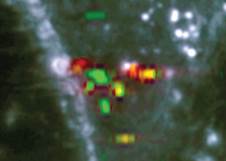Science
Scientists Replace Nanoparticles with Nanostructures to Produce Solar Cells with Higher Efficiency

- Read more
- 304 reads
ORNL superconducting wire yields unprecedented performance

This figure shows the critical current, Ic, and engineering critical current density, JE, in a superconducting wire as a function of applied magnetic field orientation at 65 Kelvin and 3 Tesla. The top curve shows results from a newly published ORNL study. The other two curves are from previously reported record values. A minimum JE of 43.7 kiloamperes/cm2 (assuming a 50 micron thick stabilizer layer) and a minimum Ic of 455 Amperes/cm was obtained for all applied field orientations. This is the highest reported performance for a superconductor wire or a film on a technical substrate.
- Read more
- 470 reads
Detecting early-stage malarial infection: New prototype device recognizes electrical properties of infected cells as signatures of disease
The scientists, from the laboratories of MIT's Anantha Chandrakasan and Subra Suresh — who is now president of Carnegie Mellon University — have built an experimental microfluidic device that takes a drop of blood and streams it across an electrode that measures a signal differentiating infected cells from uninfected cells. The work, published Aug. 8 in the journal Lab on a Chip, is a first step toward a field-ready, low-cost, portable malaria-detection device.
- Read more
- 396 reads
Cosmology in the lab using laser-cooled ions: Taking a look back at the beginning of our universe: QUEST researchers at PTB generate and investigate symmetry breaking in ion Coulomb crystals

The picture shows ytterbium ions in an ion Coulomb crystal, taken with an EMCCD camera (electron multiplying CCD camera). The ionized atoms fluoresce in the laser light; the distance between the ions is approx. 10µm to 20 µm. (a) Radial symmetry: At a high radial trap enclosure, the ionized atoms line up like a string of pearls. The radial potential felt by the positively charged particles is depicted at the bottom left. (b) Mirror symmetry: If the strength of the radial enclosure changes, the ions become free to avoid each other, and the crystal adopts a new, energetically more favourable structure. Hereby, two energetically equivalent configurations can be chosen from. Areas which do not communicate with each other decide independently of each other on a new orientation. Topological defects occur where two areas which have made different "decisions" collide. The black-and-white images show fluorescing ytterbium ions.
- Read more
- 428 reads
Researchers Optically Levitate a Glowing, Nanoscale Diamond

The researchers show photoluminescence from an optically levitated nano diamond.
- Read more
- 392 reads
Raman pixel by pixel

- Read more
- 393 reads
Material in dissolvable sutures could treat brain infections, reducing hospital stays

The challenge of delivering to the brain a continuous regimen of antibiotics in case of infection could be met with plastic nanofibers that release medication directly to the affected site.
- Read more
- 383 reads
Perseid meteors to light up summer skies

A Perseid meteor (at left) seen in August 2010 above the four enclosures of the European Southern Observatory’s Very Large Telescope at Paranal, Chile.
- Read more
- 385 reads
Human Rights
Fostering a More Humane World: The 28th Eurasian Economic Summi

Conscience, Hope, and Action: Keys to Global Peace and Sustainability

Ringing FOWPAL’s Peace Bell for the World:Nobel Peace Prize Laureates’ Visions and Actions

Protecting the World’s Cultural Diversity for a Sustainable Future

Puppet Show I International Friendship Day 2020



